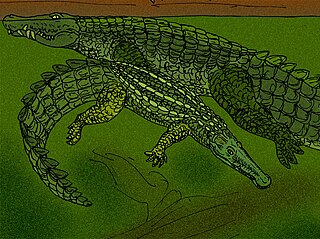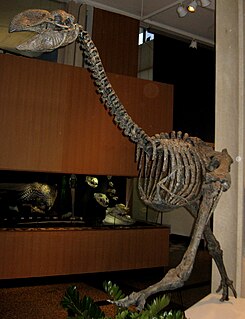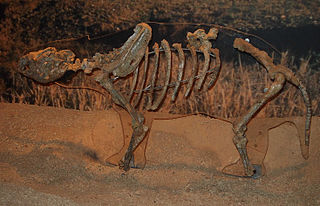Related Research Articles

Thylacinidae is an extinct family of carnivorous, superficially dog-like marsupials from the order Dasyuromorphia. The only species to survive into modern times was the thylacine, which became extinct in 1936.

The magpie goose is the sole living representative species of the family Anseranatidae. This common waterbird is found in northern Australia and southern New Guinea. As the species is prone to wandering, especially when not breeding, it is sometimes recorded outside its core range. The species was once also widespread in southern Australia, but disappeared from there largely due to the drainage of the wetlands where the birds once bred. Due to their importance to the local aboriginals as a seasonal food source, as subjects of recreational hunting, and as a tourist attraction, their expansive and stable presence in northern Australia has been "ensured protective management".
The big-eared hopping mouse is an extinct species of mouse, which lived in the Moore River area of south-western Australia. The big-eared hopping mouse was a small, rat-sized animal resembling a tiny kangaroo. It had large eyes and ears with a brush-tipped tail. It moved on its four legs when traveling at a slower pace, or by bounding upon its enlarged, padded, hind feet when traveling quickly. They mainly lived in sand dunes and made nests of leaves and other organic materials. The big-eared hopping-mouse was last collected in July 1843 near the Moore River, Western Australia, close to where New Norcia is now situated, and has not been seen since.

Baru is an extinct genus of Australian mekosuchine crocodilian. It was semi-aquatic, around 4 m (13 ft) in length. Being semi-aquatic its habitat was around fresh pools of water in wet forests, ambushing their prey, much like modern species. The word Baru is Aboriginal and means "crocodile's ancestor".

Dromornis planei, formerly placed in a separate genus Bullockornis, is an extinct flightless bird that lived in the Middle Miocene, approximately 15 million years ago. It is known from specimens of the Bullock Creek fauna, fossils found in the Northern Territory of Australia.

Dromornithidae, also commonly referred to as mihirungs, thunder birds or demon ducks, were a clade of large, flightless Australian birds of the Oligocene through Pleistocene Epochs. All are now extinct. They were long classified in Struthioniformes, but are now usually classified as galloanseres.

The Alcoota Fossil Beds are an important paleontological site in the Northern Territory of Australia located on Alcoota Station in the locality of Anmatjere about 115 kilometres (71 mi) north-east of Alice Springs in the Central Australia region. It is notable for the occurrence of well-preserved, rare, Miocene vertebrate fossils, which provide evidence of the evolution of the Northern Territory’s fauna and climate. The Alcoota Fossil Beds are also significant as a research and teaching site for palaeontology students.
The Bullock Creek Fossil site is one of three known vertebrate fossil sites in the Northern Territory of Australia, along with the Alcoota Fossil Beds on Alcoota Station and the Kangaroo Well site on Deep Well Station. It is located about 550 kilometres (340 mi) south-southeast of Darwin, on Camfield Station in the locality of Victoria River.
Wakaleo vanderleuri is a species of marsupial lion of the genus Wakaleo, that lived in Australia during the Miocene.

Sweetheart was the name given to a 5.1 m (17 ft) male saltwater crocodile responsible for a series of attacks on boats in Australia between 1974 and 1979. Sweetheart attacked outboard motors, dinghies, and fishing boats, but there is no known case of his attacking humans. In July 1979, Sweetheart was finally caught alive by a team from the Territory Parks and Wildlife Commission, but drowned while being transported when he became tangled with a log. The cause of death was later attributed to drowning, probably due to the administration of the muscle relaxant Flaxedil. The crocodile's mounted body is now on permanent display at the Museum and Art Gallery of the Northern Territory.
The genus Nimbacinus contains two species of carnivorous, quadrupedal marsupials in Australia both of which are extinct:

The Museum and Art Gallery of the Northern Territory (MAGNT) is the main museum in the Northern Territory. The museum is located in the inner Darwin suburb of Fannie Bay. The MAGNT is governed by the Board of the Museum and Art Gallery of the Northern Territory and is supported by the Museums and Art Galleries of the Northern Territory Foundation. Each year the MAGNT presents both internally developed exhibitions and travelling exhibitions from around Australia. It is also the home of the annual Telstra National Aboriginal and Torres Strait Islander Art Award, Australia's longest running Indigenous art prize.

Kolopsis is an extinct genus of diprotodontid marsupials from Australia and Papua New Guinea. It contains three species, although K. rotundus may be more closely related to other zygomaturines than to Kolopsis.

Thylacinus megiriani lived during the late Miocene, 8 million years ago; the area T. megiriani inhabited in the Northern Territory was covered in forest with a permanent supply of water.
Mutpuracinus archibaldi is an extinct carnivorous, quadrupedal marsupial that lived during the middle Miocene and is the smallest known thylacinid at approximately 1.1 kilograms, the size of a quoll, though, more closely related to the recently extinct thylacine.
Nimbacinus richi lived during the middle Miocene and has been found in deposits in Bullock Creek in the Northern Territory of Australia.
Tyarrpecinus rothi is an extinct thylacinid marsupial that lived during the late Miocene and has been found at the Alcoota scientific reserve in the Northern Territory. The specific name honors Karl Roth for his contributions to the natural history of central Australia.
Thylacoleo hilli lived during the Pliocene and was half the size of Thylacoleo crassidentatus.
Aquila bullockensis is an extinct species of large true eagles in the family Accipitridae. A. bullockensis is related to the living species A. audax to which it might be ancestral. The species is solely known from the distal end of a right humerus found in the Middle Miocene, Bullock Creek deposits in Australia. A. bullockensis is the oldest confirmed record of the genus Aquila in Australia, and possibly in the world.
Propalorchestes is a fossil genus of Diprotodontidae, mammals that existed in Australia.
References
- ↑ Terzon, Emilia (4 August 2016). "How Darwin's iconic five-metre croc Sweetheart got stuffed". ABC News.
- ↑ Nelson, Patrick (November 2016). "Art classes boost retiree's zest for life". Enews (21). Charles Darwin University . Retrieved 11 August 2019.CS1 maint: discouraged parameter (link)
- ↑ Murray, P.; Megirian, D. (2000). "Two New Genera and Three New Species of Thylacinidae (Marsupialia) from the Miocene of the Northern Territory, Australia". The Beagle : occasional papers of the Northern Territory Museum of Arts and Sciences. 16: 145–162.